Uncertainty and Sensitivity Analysis at Low Value of Determination Coefficient of Regression Analysis: Case of I-129 Release from RBMK-1500 SNF under Disposal Conditions
Abstract
:1. Introduction
1.1. Radionuclide Transport Model for RBMK-1500 SNF Disposal
1.1.1. Disposal System
- The bentonite material surrounding copper canister will be fully saturated by the groundwater by the time I-129 release from the SNF assemblies;
- As soon as a small initial canister defect becomes large, the void space within the canister (void between SNF assemblies and the channel in the canister insert) will be filled with the groundwater (app. 0.5 m3);
- Mechanisms (instant release of a part of the inventory and congruent release of the rest part of the inventory from degrading SNF matrix) take place in the canister and contribute to the radionuclide flux from the canister;
- Radionuclides released from SNF assemblies interact with a limited amount of water inside the canister, and dissolved radionuclide are transported from the canister in liquid form (mainly by diffusion);
- I-129 is released through the bentonite barrier and diffuses into the water flowing in a (conceptual) fracture intersecting the disposal tunnel.
1.1.2. Characterization of Model Behavior
2. Methodology/Approach for Extension of Sensitivity Analysis Based on CSM and CSV
2.1. Contribution to Sample Mean (CSM)
- The randomly (quasi-randomly) generated values of from its probability distribution function (PDF) are sorted in ascending order, generating the series of values , ;
- The output values corresponding to sorted input are obtained too , ;
- An ancillary variable Mi is calculated, whose values are calculated from asi.e.: , , , etc.
- The function is obtained by normalization of , i.e., dividing the values by the sample mean of model output :
- Cumulative relative frequency (cumulative fraction) of the sorted input parameter lies in the interval [0,1] and could be calculated:
- Then, the function is plotted versus the cumulative relative frequency of . CSM also lie in the interval [0,1].
2.2. Contribution to Sample Variance (CSV)
- The output mean is computed, and each value of output is transformed by subtracting the mean value . The transformed output has zero mean value.
- The randomly (quasi-randomly) generated values of input are sorted in ascending order, generating the series of values , , and the corresponding set of the transformed outputs is obtained , .
- Function CSV is obtained as follows
- Cumulative relative frequency (cumulative fraction) of the sorted input parameter lies in the interval [0,1] and could be calculated by Equation (4).
2.3. Revised Mean and Variance Ratio Functions
- The mean of model output is computed.
- The generated values of the input Xi are sorted in ascending order, generating the series of values , , and the corresponding set of model output values , is obtained.
- Cumulative fractions of the input parameter lying in the interval [0,1] are defined:
- The mean ratio function and variance ratio function for can be estimated by the following expressions
3. Results and Discussion
3.1. CSM and CSV Plots for I-129 Flux
3.2. Effect of Parameter Range Reduction on Mean and Variance of I-129 flux
- on mean I-129 flux at time t = 5 × 104 (peak time),
- on the variance of I-129 flux at time t = 5 × 104 (peak time),
- on mean flux over time.
- impact of increasing the lower bounding value and decreasing upper bounding value,
- impact of increasing the lower bounding value while maintaining the original upper bounding value,
- impact of decreasing the upper bounding value while maintaining the original lower bounding value.
3.2.1. Mean Ratio Function
- (a)
- a plot of HM keeping the lower bounding value of input parameter at q1 = 0 and varying the upper bounding value (from q2 = 0 to q2 = 1);
- (b)
- a plot of HM keeping the upper bounding value of input parameter fixed at q2 = 1 and varying the lower bounding value (from q1 = 0 to q1 = 1).
3.2.2. Variance Ratio Function
- (a)
- reduced upper bound and
- (b)
- increased lower bound of the range of each parameter (at t5 = 5 × 104 years corresponding to the time of maximal mean flux).
3.3. Effect of Parameter Uncertainty Reduction on Mean Flux over Time
3.4. Summary of Discussion
4. Conclusions
- The CSM identified defect size enlargement time on the I-129 time-dependent flux to have greater importance relative to the effective diffusivity in bentonite and instant release fraction of I-129 (identified in regression analysis) at earlier time points (for a period of 5 × 103–5 × 104 years after the repository closure). This importance ranking overcame the results from the regression analysis.
- The importance of defect size enlargement time was confirmed with the CSV method; its largest contribution to the variance of I-129 flux into the geosphere occurred at a time from 5 × 103–104 years after repository closure.
- Soon after the onset of radionuclide release, the most significant contributing parameter to the mean flux and its variance was effective diffusivity of I-129 in bentonite. For longer periods (up to 1 Million years after repository closure), the SNF dissolution rate was observed as the most significant contributor to the mean flux and its variance. These observations were in line with the results of the regression analysis.
- At t = 5 × 104 years after repository closure (time of maximal mean flux), the most significant contributor to the mean flux was the SNF dissolution rate; however, the most significant contributor to flux variance was the defect size enlargement time.
- The effect of decreased mean flux before t = 5 × 104 years after repository closure was observed from reduced defect size enlargement time uncertainty: if the lowest bounding value of the defect size enlargement time is increased to be 4.6 × 104 years (parameter value at q1 = 0.65), then the mean flux at t = 5 × 103–2 × 104 years would be lower. Almost no effect on the mean flux would occur at t = 5 × 104 years after repository closure. If such input parameter range is not justified, then the increase to q1 < 0.65 would lead to a lower mean at earlier time points and an increased mean (to some extent) at t = 5 × 104 years after repository closure.
- If justification of the upper bounding value of the defect size enlargement time would lead to a value less than 4.6 × 104 years (parameter value at q2 less than 0.65), this would result in a decreased mean flux at t = 5 × 104 years after the repository closure would be expected; however, this would cause increase in the mean flux at earlier time points. Fixing the upper bounding value of Tlarge to a value at q2 = 0.6 would lead to the lower mean flux at t = 5 × 104 years, but at earlier time t = 1 × 104 years, t = 2 × 104 years, the mean of flux would be greater by a factor of ~ 1.5.
- The effect of decreased mean flux in the long-term (up to 1 million years after closure) was observed in case of a justified reduction of the upper bound of the SNF dissolution rate only. Reducing parameter SNF DR uncertainty range from [10−8, 10−6] 1/year to [10−8, 5.7 × 10−7] 1/year (q2 = 0.8) would lead to a decrease of mean flux by at least a factor of 1.14.
- CSM, CSV plots, and derived mean (variance) ratios have the potential to be applied more widely in the context of radioactive waste disposal as a means of complementing regression-based sensitivity analyses.
Author Contributions
Funding
Conflicts of Interest
References
- EC Directive 2011/70/Euratom. Available online: https://eur-lex.europa.eu/legal-content/EN/TXT/?uri=celex%3A32011L0070 (accessed on 20 March 2019).
- Mellado, M.; Cisternas, L.A.; Lucay, F.A.; Gálvez, E.D.; Sepúlveda, F.D. A Posteriori Analysis of Analytical Models for Heap Leaching Using Uncertainty and Global Sensitivity Analyses. Minerals 2018, 8, 44. [Google Scholar] [CrossRef]
- Frey, H.C.; Patil, S.R. Identification and Review of Sensitivity Analysis Methods. Risk Anal. 2002, 22, 553–578. [Google Scholar] [CrossRef] [PubMed]
- Saltelli, A.; Annoni, P. How to avoid a perfunctory sensitivity analysis. Environ. Model. Softw. 2010, 25, 1508–1517. [Google Scholar] [CrossRef]
- Cadinia, F.; De Sanctis, J.; Cherubini, A.; Zio, E.; Rivac, E.; Guadagnini, A. Nominal range sensitivity analysis of peak radionuclide concentrations in randomly heterogeneous aquifers. Ann. Nucl. Energy 2012, 47, 166–172. [Google Scholar] [CrossRef]
- Pohjola, J.; Turunen, J.; Lipping, T.; Ikonen, A. Probabilistic assessment of the influence of lake properties in longterm radiation doses to humans. J. Environ. Radioact. 2016, 164, 258–267. [Google Scholar] [CrossRef]
- Sinclair, J. Response to the PSACOIN Level S Exercise. PSACOIN Level S Intercomparison; Nuclear Energy Agency OECD: Paris, France, 1993. [Google Scholar]
- Albrecht, A.; Miquel, S. Extension of sensitivity and uncertainty analysis for long term dose assessment of high level nuclear waste disposal sites to uncertainties in the human behaviour. J. Environ. Radioact. 2010, 101, 55–67. [Google Scholar] [CrossRef] [PubMed]
- Aguero, A. Performance assessment model development and parameter acquisition for analysis of the transport of natural radionuclides in a Mediterranean watershed. Sci. Total Environ. 2005, 348, 32–50. [Google Scholar] [CrossRef]
- Aguero, A.; Pined, P.; Cancio, D.; Simon, I.; Moraleda, M.; Perez-Sanchez, D.; Trueba, C. Spanish methodological approach for biosphere assessment of radioactive waste disposal. Sci. Total Environ. 2007, 384, 36–47. [Google Scholar] [CrossRef]
- Aguero, A.; Pinedo, P.; Simón, I.; Cancio, D.; Moraleda, M.; Trueba, C.; Pérez-Sánchez, D. Application of the Spanish methodological approach for biosphere assessment to a generic high-level waste disposal site. Sci. Total Environ. 2008, 403, 34–58. [Google Scholar] [CrossRef]
- Helton, J.C. Uncertainty and sensitivity analysis techniques for use in performance assessment for radioactive waste disposal. Reliab. Engng. Syst. Saf. 1993, 42, 327–367. [Google Scholar] [CrossRef]
- Helton, J.C.; Davis, F.J.; Johnson, J.D. A comparison of uncertainty and sensitivity analysis results obtained with random and Latin hypercube sampling. Reliab. Engng. Syst. Saf. 2005, 89, 305–330. [Google Scholar] [CrossRef]
- Bolado-Lavin, R.; Castaings, W.; Tarantola, S. Contribution to the sample mean plot for graphical and numerical sensitivity analysis. Reliab. Engng. Syst. Saf. 2009, 94, 1041–1049. [Google Scholar] [CrossRef]
- Tarantola, S.; Kopustinskas, V.; Bolado-Lavin, R.; Kaliatka, A.; Uspuras, E.; Vaisnoras, M. Sensitivity analysis using contribution to sample variance plot: Application to a water hammer model. Reliab. Engng. Syst. Saf. 2012, 99, 62–73. [Google Scholar] [CrossRef]
- Spiessl, S.M.; Becker, D.A.; Rubel, A. EFAST analysis applied to a Pa model for a generic HLW repository in clay. Reliab. Engng. Syst. Saf. 2012, 107, 190–204. [Google Scholar] [CrossRef]
- Poskas, P.; Brazauskaite, A. Modeling of radionuclide releases from the geological repository for RBMK-1500 spent nuclear fuel in crystalline rocks in Lithuania. In Proceedings of the 11th International Conference ICEM2007, Bruges, Belgium, 2–6 September 2007. [Google Scholar]
- Poskas, P.; Narkuniene, A.; Grigaliuniene, D.; Kilda, R. Analysis of radionuclide release through EBS of conceptual repository for Lithuanian RBMK spent nuclear fuel disposal—Case of canister with initial defect. Nukleonika 2013, 58, 487–495. [Google Scholar]
- Poskas, P.; Narkuniene, A.; Grigaliuniene, D.; Finsterle, S. Comparison of radionuclide releases from a conceptual geological repository for RBMK-1500 and BWR spent nuclear fuel. Nucl. Technol. 2014, 185, 322–335. [Google Scholar] [CrossRef]
- IAEA Tecdoc No. 1372. Safety Indicators for the Safety Assessment of Radioactive Waste Disposal; IAEA: Vienna, Austria, 2003. [Google Scholar]
- Narkuniene, A.; Poskas, P.; Kilda, R.; Bartkus, G. Uncertainty and sensitivity analysis of radionuclide migration through the engineered barriers of deep geological repository: Case of RBMK-1500SNF. Reliab. Engng. Syst. Saf. 2015, 136, 8–16. [Google Scholar] [CrossRef]
- Romero, L.; Moreno, L.; Neretnieks, I. Sensitivity of the radionuclide release from a repository to the variability of materials and other properties. Nucl. Technol. 1996, 113, 316–326. [Google Scholar] [CrossRef]
- Shahkarami, P.; Liu, L.; Moreno, L.; Neretnieks, I. Radionuclide migration through fractured rock for arbitrary-length decay chain: Analytical solution and global sensitivity analysis. J. Hydrol. 2015, 520, 448–460. [Google Scholar] [CrossRef]
- Hedin, A. Probabilistic dose calculations and sensitivity analyses using analytic models. Reliab. Engng. Syst. Saf. 2003, 79, 195–204. [Google Scholar] [CrossRef]
- Stockman, C.T.; Garner, J.W.; Helton, J.C.; Johnson, J.D.; Shinta, A.; Smith, L.N. Radionuclide transport in the vicinity of the repository and associated complementary cumulative distribution functions in the 1996 performance assessment for the Waste Isolation Pilot Plant. Reliab. Engng. Syst. Saf. 2000, 69, 369–396. [Google Scholar] [CrossRef] [Green Version]
- Helton, J.C.; Hansen, C.W.; Sallaberry, C.J. Uncertainty and sensitivity analysis in performance assessment for the proposed high-level radioactive waste repository at Yucca Mountain. Nevada. Reliab. Engng. Syst. Saf. 2012, 107, 44–63. [Google Scholar] [CrossRef]
- Helton, J.C.; Johnson, J.D.; Sallaberry, C.J.; Storlie, C.B. Survey of sampling-based methods for uncertainty and sensitivity analysis. Reliab. Engng. Syst. Saf. 2006, 91, 1175–1209. [Google Scholar] [CrossRef] [Green Version]
- Ragoussi, M.E.; Costa, D. Fundamentals of the NEA Thermochemical Database and its influence over national nuclear programs on the performance assessment of deep geological repositories. J. Environ. Radioact. 2019, 196, 225–231. [Google Scholar] [CrossRef] [PubMed]
- Malekifarsani, A.; Skachek, M.A. Effect of precipitation, sorption and stable of isotope on maximum release rates of radionuclides from engineered barrier system (EBS) in deep repository. J. Environ. Radioact. 2009, 100, 807–814. [Google Scholar] [CrossRef] [PubMed]
- Long-Term Safety for KBS-3 Repositories at Forsmark and Laxemar—A First Evaluation. Main Report of the SR-Can Project; SKB Technical Report TR-06-09; Swedish Nuclear Fuel and Waste Management Co.: Stockholm, Sweden, 2006.
- Werme, L.O.; Johnson, L.H.; Oversby, V.M.; King, F.; Spahiu, K.; Grambow, B.; Shoesmith, D.W. Spent Fuel Performance under Repository Conditions: A Model for Use in SR-Can; SKB Technical Report TR-04-19; Swedish Nuclear Fuel and Waste Management Co.: Stockholm, Sweden, 2004. [Google Scholar]
- Nordman, H.; Vieno, T. Equivalent Flow Rates from Canister Interior into the Geosphere in a KBS-3H Type Repository; Working report 2004-06; Posiva Oy: Eurajoki, Finland, 2004. [Google Scholar]
- Ochs, M.; Talerio, C. Data and Uncertainty Assessment. Migration Parameters for the Bentonite Buffer in the KBS-3 concept; SKB Technical Report TR-04-18; Swedish Nuclear Fuel and Waste Management Co.: Stockholm, Sweden, 2004. [Google Scholar]
- Enviros Quanitsci. AMBER 4.4. Getting Started. Version 1.0/User’s Manual; Enviros Quanitsci: Oxfordshire, UK, 2002. [Google Scholar]
- Manache, G.; Melching, C.S. Identification of reliable regression-and correlation-based sensitivity measures for importance ranking of water-quality model parameters. Environ. Model. Softw. 2008, 23, 549–562. [Google Scholar] [CrossRef]
- Wei, P.; Lu, Z.; Ruan, W.; Song, J. Regional sensitivity analysis using revised mean and variance ratio functions. Reliab. Engng. Syst. Saf. 2014, 121, 121–135. [Google Scholar] [CrossRef]


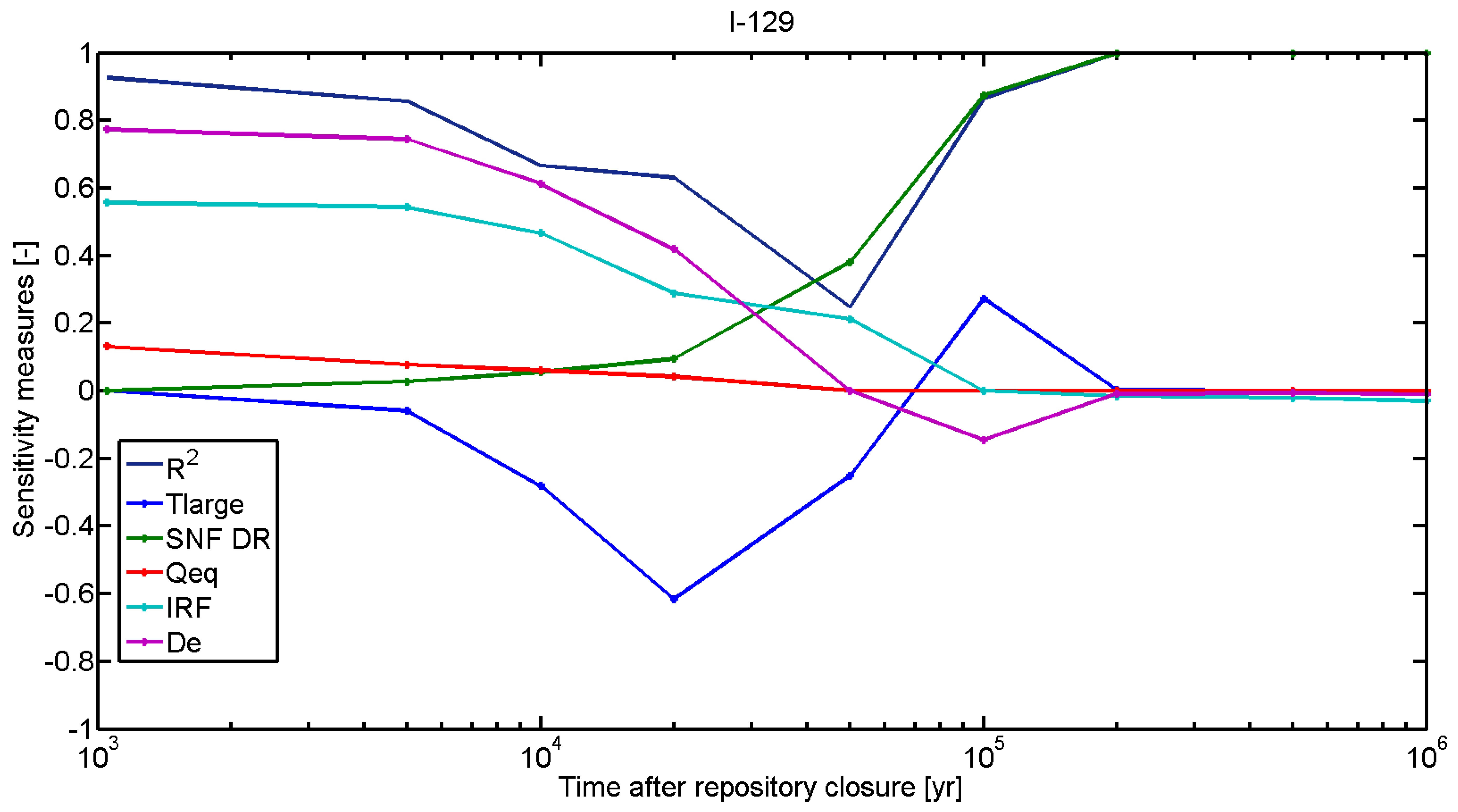

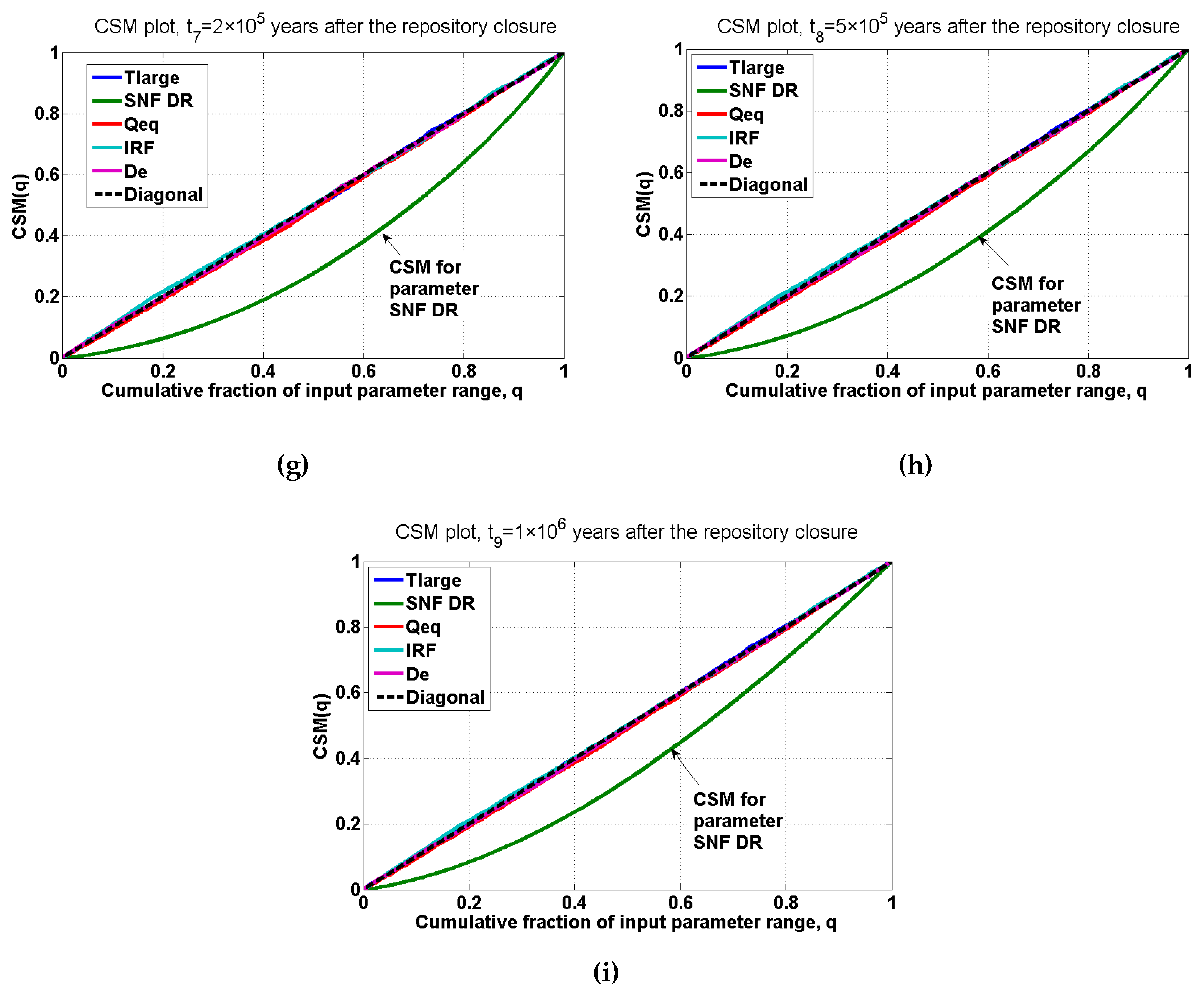

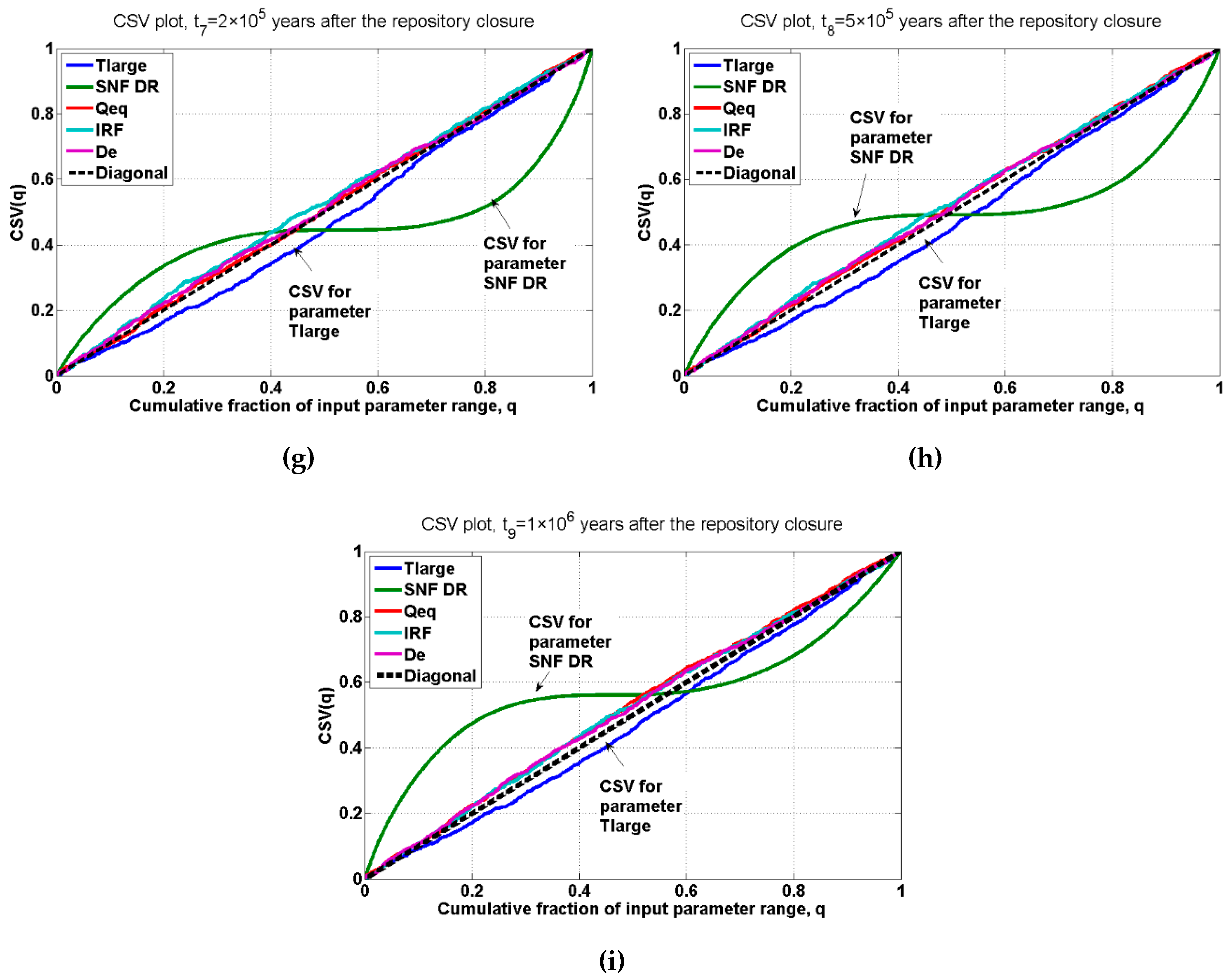
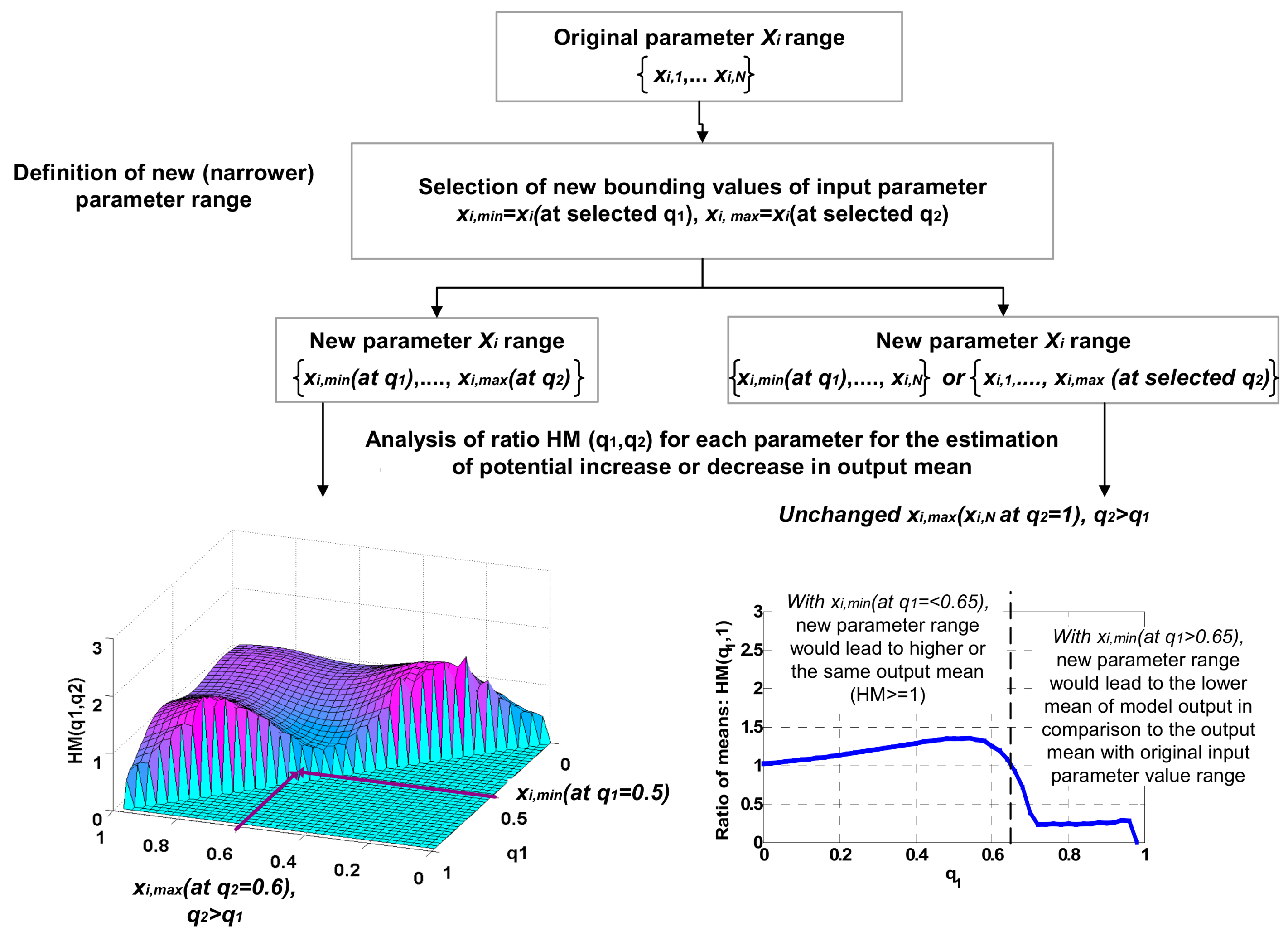


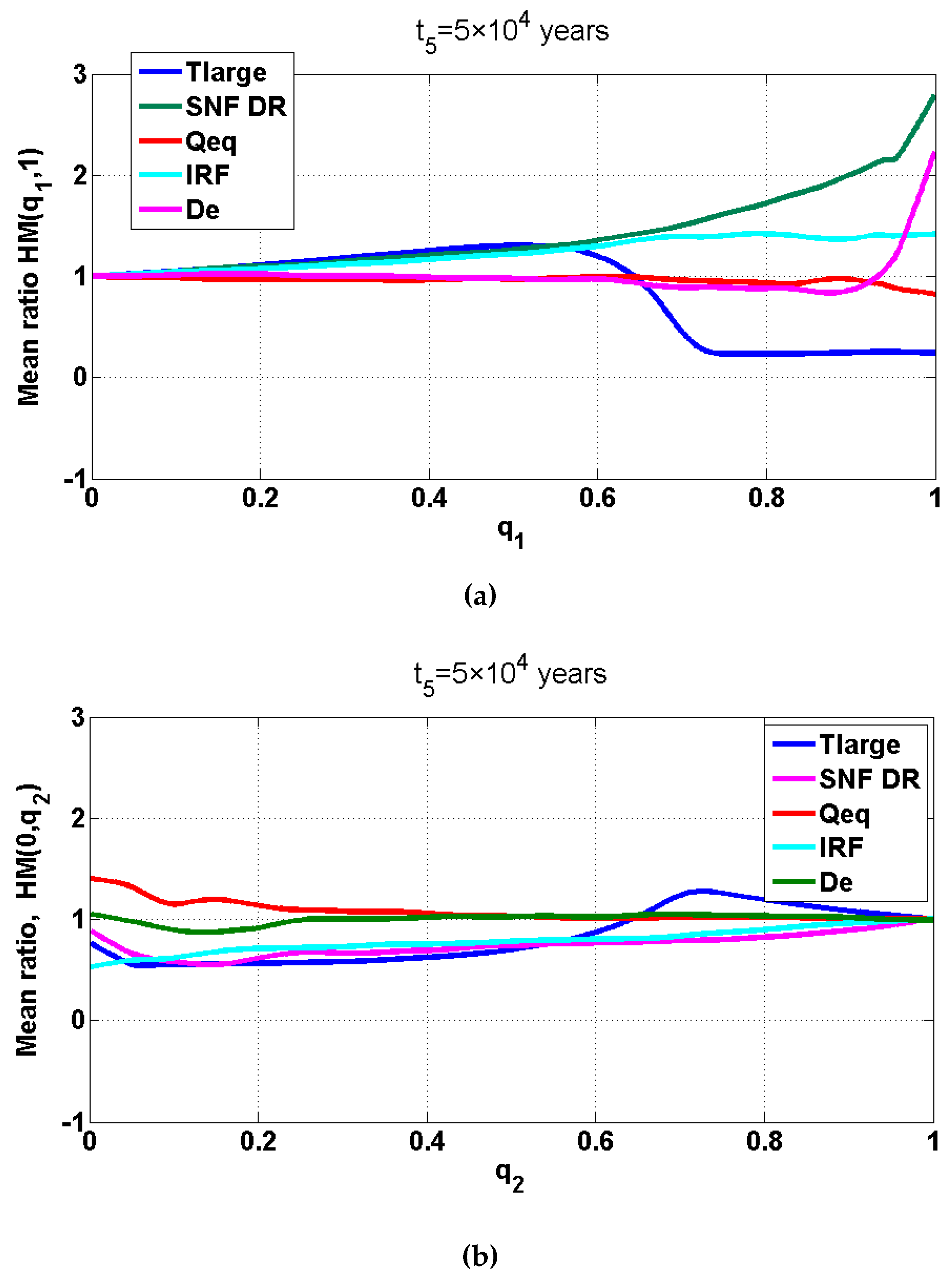

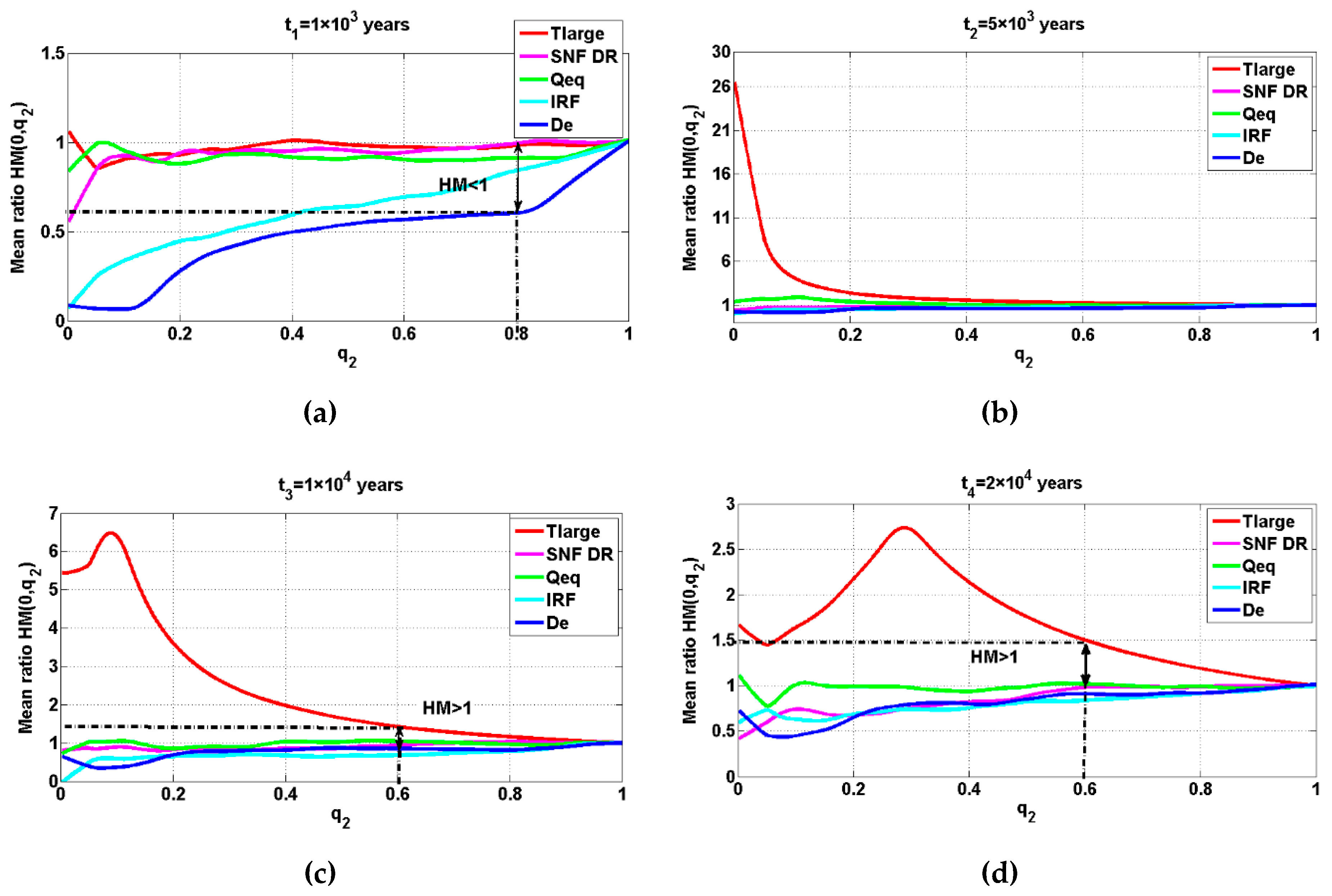


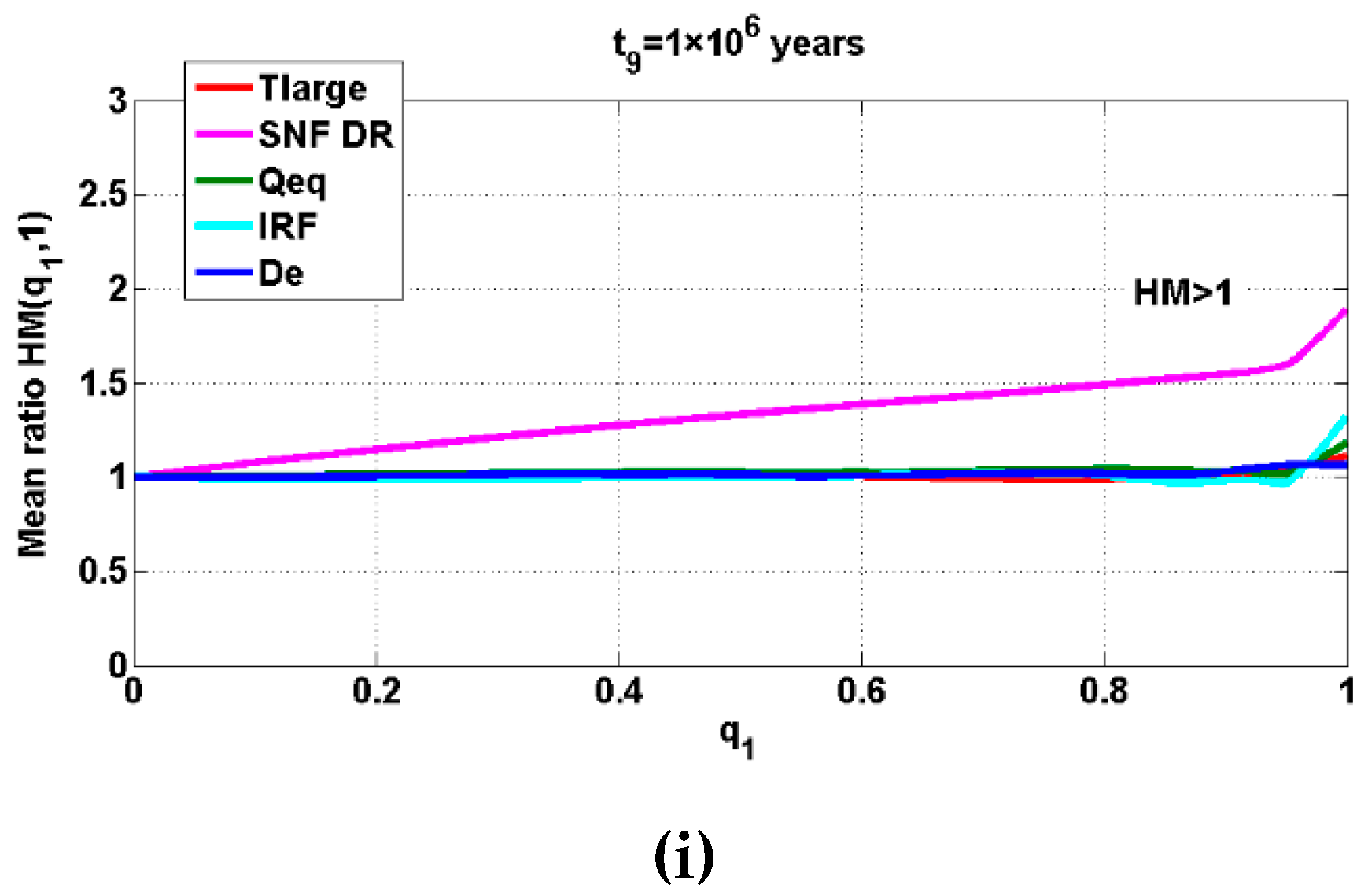
| Parameter | PDF 1 | PDF Type | ||
|---|---|---|---|---|
| Nominal Value (Reference Value) | Lower Bound | Upper Bound | ||
| Defect size enlargement time (Tlarge) (years) [30] | 104 | 103 | 105 | Triangular |
| SNF matrix dissolution rate (SNF DR) (1/year) [31] | 10−7 | 10−8 | 10−6 | Triangular |
| Equivalent groundwater flow rate around the canister (Qeq) (m3/year) [32] | 9 × 10−4 | 9 × 10−4 (p = 0.9) | 4 (p = 0.1) | Discrete |
| Instant release fraction (IRF) of I-129 inventory (%) [31] | 2 | 0 | 5 | Triangular |
| Effective diffusivity of I-129 in bentonite (De) (m2/s) [33] | 1 × 10−11 | 3 × 10−12 (p = 0.15) 1 × 10−11 (p = 0.7) 3 × 10−11 (p = 0.15) | Discrete | |
| Time, Years | Most Important Parameters by Regression Analysis [21] | Most Important Parameters by CSM | Most Important Parameters by CSV | Notes |
|---|---|---|---|---|
| t1 = 1 × 103 years | De, IRF | De, IRF | De | IRF, Qeq are also significant based on CSV |
| t2 = 5 × 103 years | De, IRF | Tlarge, De, IRF | Tlarge, Qeq, De, IRF | Small Qeq values and De, IRF, are important to some extent |
| t3 = 104 years | De, IRF, Tlarge | Tlarge, IRF | Tlarge, IRF | The same for both (CSM and CSV) methods |
| t4 = 2 × 104 years | Tlarge, De | Tlarge | Tlarge | Low importance of SNF DR, De, IRF |
| t5 = 5 × 104 years | SNF DR, Tlarge | Tlarge, SNF DR, IRF | Tlarge | Ranking of the most important parameter is the same for both (CSM and CSV) methods |
| t6 = 105 years | SNF DR, Tlarge | SNF DR, Tlarge | Tlarge | Ranking of the most important parameter differs |
| t7 = 2×105 years | SNF DR | SNF DR | SNF DR | Based on CSM, the rest parameters are non-influential and could be assigned a fixed value without influence on the mean flux for this time. Smallest and largest values of SNF DR are more contributing to flux variance; low importance of Tlarge based on CSV |
| t8 = 5 × 105 years | SNF DR | SNF DR | SNF DR | |
| t9 = 106 years | SNF DR | SNF DR | SNF DR |
© 2019 by the authors. Licensee MDPI, Basel, Switzerland. This article is an open access article distributed under the terms and conditions of the Creative Commons Attribution (CC BY) license (http://creativecommons.org/licenses/by/4.0/).
Share and Cite
Narkuniene, A.; Poskas, P.; Justinavicius, D. Uncertainty and Sensitivity Analysis at Low Value of Determination Coefficient of Regression Analysis: Case of I-129 Release from RBMK-1500 SNF under Disposal Conditions. Minerals 2019, 9, 521. https://doi.org/10.3390/min9090521
Narkuniene A, Poskas P, Justinavicius D. Uncertainty and Sensitivity Analysis at Low Value of Determination Coefficient of Regression Analysis: Case of I-129 Release from RBMK-1500 SNF under Disposal Conditions. Minerals. 2019; 9(9):521. https://doi.org/10.3390/min9090521
Chicago/Turabian StyleNarkuniene, Asta, Povilas Poskas, and Darius Justinavicius. 2019. "Uncertainty and Sensitivity Analysis at Low Value of Determination Coefficient of Regression Analysis: Case of I-129 Release from RBMK-1500 SNF under Disposal Conditions" Minerals 9, no. 9: 521. https://doi.org/10.3390/min9090521




